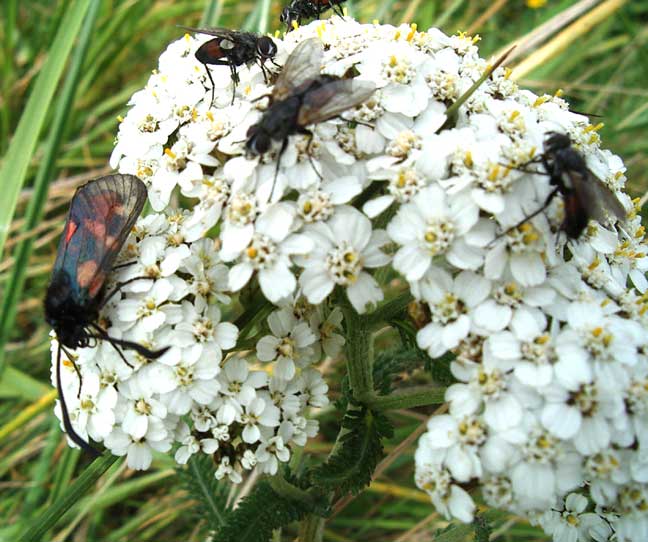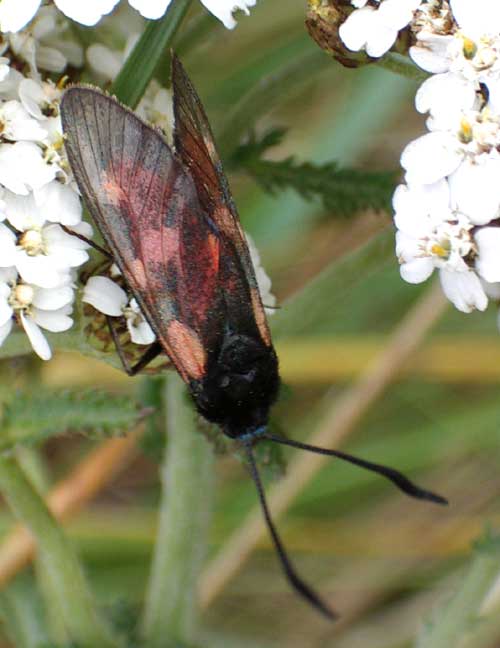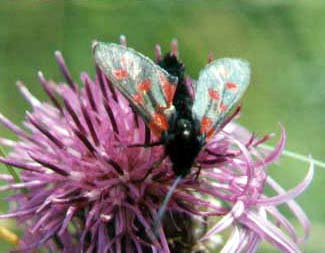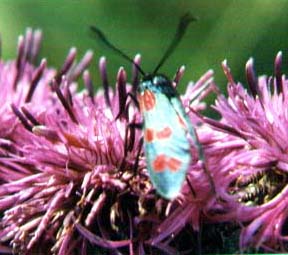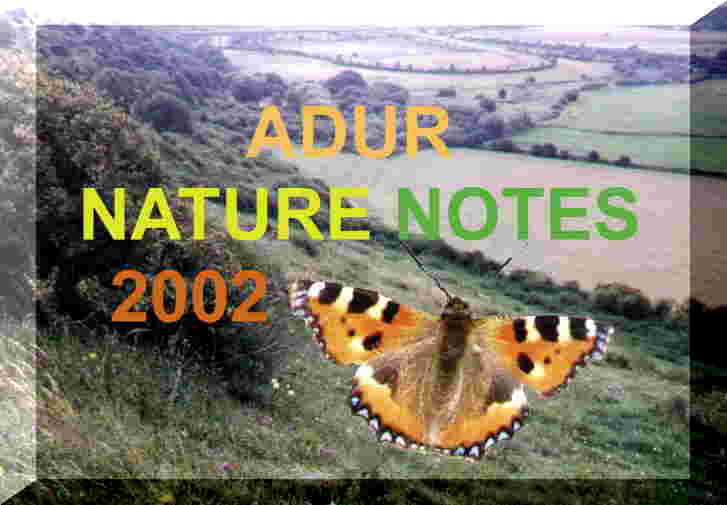Burnet Moths
The most frequently encountered
species is the 6-spot Burnet Moth in
late July on the downs,
but 5-spot
Burnet Moths occur earlier in the year
25
June 2010
A
Narrow-bordered
Five-spot Burnet Moth was spotted on a
Hardhead
flower
on the short path through the broken gate between the Coastal-Downs
Link Cyclepath and the towpath on the bend of the River
Adur.
A
Burnet
Moth was seen on the towpath just north of
the Toll
Bridge earlier in the day. But it flew
around constantly and its identity could not be determined. |
 |
|
20
June 2010
On
the open part of the path that runs parallel with the dual carriageway
at the top of the southern embankment of the the Slonk
Hill Cutting, the first Six-spotted
Burnet Moth settled on the first Tufted
Vetch noted in flower
this year. |
|
|
 |
8
June 2010
In
the late afternoon, 5:45 pm,
Greater
Bird's Foot Trefoil hosted a small Burnet
Moth caterpillar on the southern bank
of Buckingham Cutting. |
16
July 2009
Six-spotted
Burnet Moths were frequently seen both
on Buckingham Cutting (south), north Shoreham,
and on Mill Hill.
1
July 2009
 |
 |
Narrow-bordered
Five-spot
Burnet Moth
Holmbush
Close Field, north Southwick
|
Six-spotted
Burnet Moth
Buckingham
Cutting (south),
north
Shoreham
|
29
June 2009
On
the Adur Levels, in a field north of Cuckoo's
Corner, a few Narrow-bordered Five-spot
Burnet Moths, Zygaena lonicerae, visited
Tufted
Vetch, for the first record in 2009.
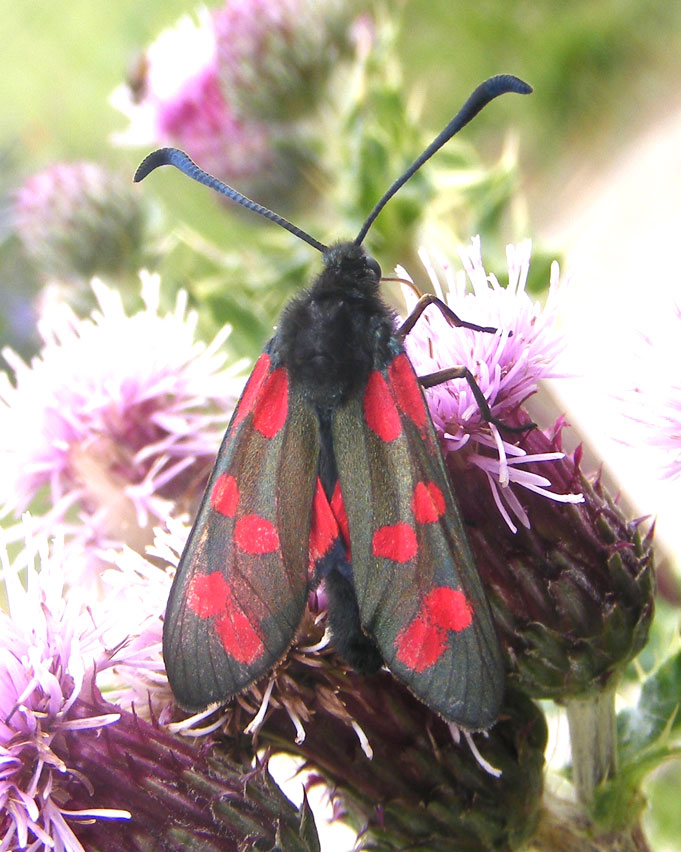
|

|
|
Six-spotted
Burnet Moth
|
Narrow-bordered
Five-spot Burnet Moths
|
12
June 2009
My
first of the year Six-spotted Burnet Moth
was one of two on Creeping Thistle
at the back of Dacre Gardens next to Anchor
Bottom, Upper Beeding.
14
July 2008
On
Greater
Knapweed, the first confirmed Six-spotted
Burnet Moths were spotted on the south-facing
Horseshoe
Vetch slope of Anchor Bottom, Upper Beeding.
29
July 2007
Frequent
6-spot
Burnet Moths were seen on the breeze-swept
plateau on Mill Hill, most often visiting
Greater
Knapweed and Field
Scabious.
 Reports
with dates:
Reports
with dates:
22
July 2007
On
Anchor
Bottom, Upper Beeding (Dacre Garden entrance) there were over twenty
Six-spot
Burnet Moths. Their preferred choice of
flower was Scabious.
14
July 2007
There
were a handful of 6-spot Burnet Moths whirring
around south of Old Shoreham Toll
Bridge.
13
July 2007
I
stopped at the Downs Link Cyclepath verge meadow just south of the Cement
Works where there were a handful of 6-spot
Burnet Moths whirring in between the herbs.They
showed a preference for landing on Creeping
Thistle.
8
July 2007
This
6-spot
Burnet Moth was seen on Mill Hill. |
 |
1 July
2007
My
first 6-spot Burnet Moth of
the year visited a flowering Buddleia
on the Downs Link path south of the
Toll
Bridge.
23
July 2006
At
least, in the late morning it was a bit cooler (after
the thunderstorms of 22
July 2006) mostly
overcast at 24.1 ºC from 11:00 am,
and tolerable for watching Lepidoptera.
Six-spot
Burnet Moths were frequently seen and
frequently overlooked on the lower slopes
of Mill Hill.
Adur
Moths
12
July 2006
6-spot
Burnet Moths were seen on the Coastal
Link Cyclepath.
11
July 2006
6-spot
Burnet Moths and Silver
Y Moths were frequently seen on Slonk
Hill south and Mill Hill.
28
June 2006
A
handful of the first Burnet Moths
of the year were seen on Lancing Ring
meadows and around the dewpond. The abdomens of these were moths were bright
blue. The spots were not counted as they were too flighty.
8
July 2005
Burnet
Moths were flying over Mill Hill and emerging
from their cocoons. Most seemed to be Six-spot
Burnets, and some seem to have faded their
last spot, and one could have been a 5-spotted one.
29
June 2005
 |
On
the rough ground south of the Elm Corridor in New Monks Farm (west) a dozen
of the first Burnet Moths
of the year were first recorded. However, this was just the first time
I had seen them settled and some of the earlier Cinnabar
Moths reported were Burnets.
They were most likely to have been the
Narrow-bordered
Five-spot Burnet Moth, Zygaena lonicerae. |
20
July 2004
A
sea mist rolled over the Lancing Ring meadows
and there were a few spots of rain. 6-spot
Burnet Moths were emerging from their
cocoons.
Images
19
July 2004
There
were over 40 Six-spot Burnet Moths
on Mill Hill.
15
July 2004
On
the upper slopes of Mill Hill, there
was a very faded Burnet Moth
illustrated below.
29
June 2004
There
was a Burnet Moth
with a striking blue striped abdomen (below
right). This was originally thought ( I made
this identification because of the blue colour which was most striking
and I was disappointed that I did not chase the moth around enough to get
a decent photograph) to be the Narrow-bordered
Five-Spot Burnet Moth,
Zygaena
lonicerae.
However, it it was perhaps
even more likely to be a late flyer of the Five-Spot
Burnet Moth, Zygaena
trifolii ssp. palustrella.
Message
from Trevor Boyd on UK Leps
Report
with Image
Adur
Burnet Moths
Images
(Photographs by Mike Wall)
Burnet
larvae feeding on Clover (May 2003)
 |
If
the larval food plant is Greater Bird's-foot Trefoil and the habitat is
marshy, it sounds like Five-spot Burnet (Zygaena
trifolii) subsp. decreta, but this
is no longer found east of the New Forest as far as I know. The flight
time is late June to early August, but as your picture shows a rather worn
specimen at end June, it might indicate something else. Subsp.
palustrella
is found on chalk downland south of the Thames (this includes Sussex) and
flies earlier - mid May to mid June. Larval foodplant in this case is Bird's-foot
Trefoil.
The
Narrow-bordered
Five-spot Burnet (Zygaena lonicerae subsp. latomarginata)
is certainly in your area, found on both marshes and chalk downs, and flies
from late June to July.
Both
species have a blue-green sheen, but Z.
lonicerae rarely shows confluence of the
two middle spots while Z. trifolii
often shows them merged, and there is much more variability of the spots.
Altogether
not conclusive either way! They are not easy to tell apart.
|
19
June 2004
On
the southern bank of the A27 Shoreham By-pass
(Buckingham to Slonk Hill South) there was one
Burnet
Moth caterpillar crawling up the stalk of a Greater
Bird's Foot Trefoil plant. The height
of this plant was at least 24 cm. It was not upright though but either
wind blown or prostrate. The recognised food plants of the 6-spot Burnet
Moth (flies in June and July) caterpillars in England is Bird's
Foot Trefoil, but for the 5-spot larger
subspecies decreta (flies in July and early August) it is
the Greater Bird's Foot Trefoil, and
for the smaller subspecies palustrella (flies on downland
in May and June) it is Bird's Foot Trefoil.
| Common
Bird's-foot Trefoil |
Lotus
corniculatus |
| Greater
Bird's-foot Trefoil |
Lotus
uliginosus |
|
|
|
|
 18
June 2004
18
June 2004
A
caterpillar
discovered
crawling over the Dogwood on Lancing Clump
is one of the Burnet moth larva, but which one, the 6-spot,
Zygaena
filipendulae?
27
July 2001
I
went up the the Lancing Ring chalk pits (east
side) (TQ 187 063)
to try and find out what burnet moths they were by counting the spots.
This was difficult because these moths would not settle. There were
about 15 moths in a couple of small meadows, attracted to Greater
Knapweed.
UK-LEPS
Discussion Group (for Butterflies and Moths)
Cornish
Moths
18
July 2001
The
only insect of note on Mill Hill was a solitary
Burnet Moth south of the car park (TQ 212
072). It quickly flew away, the bright red
most distinguishable. One of the reasons for my identification was the
cocoon photographed at the end of July 2002
and shown below (this replaced an earlier photograph of July
2000).







 Reports
with dates:
Reports
with dates:








